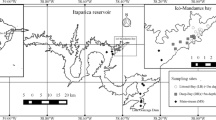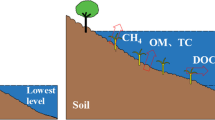Abstract
This paper discusses emissions by power-dams in the tropics. Greenhouse gas emissions from tropical power-dams are produced underwater through biomass decomposition by bacteria. The gases produced in these dams are mainly nitrogen, carbon dioxide and methane. A methodology was established for measuring greenhouse gases emitted by various power-dams in Brazil. Experimental measurements of gas emissions by dams were made to determine accurately their emissions of methane (CH4) and carbon dioxide (CO2) gases through bubbles formed on the lake bottom by decomposing organic matter, as well as rising up the lake gradient by molecular diffusion.The main source of gas in power-dams reservoirs is the bacterial decomposition (aerobic and anaerobic) of autochthonous and allochthonous organic matter that basically produces CO2 and CH4. The types and modes of gas production and release in the tropics are reviewed.
Similar content being viewed by others
References
Adams, D.: 1996, 'Aquatic Cycling and Hydrophere to Troposphere Transport of Reduced Trace Gases-A Review', Mitt. Internat. Verein. Limnol. 25, 1-13.
Alvald, P. C., Kirchorff, V. W. J. H., and Pavão, H. G.: 1998, O Metano na Atmosfera-Pro-ducão de Metano em Regiões de Queimadas e Áreas Alagadas, Revista Biotecnologia, Ciência e Desenvolvimento.
Bartlett, K. B., Crill, P. M., Sebacher, D. I., Harriss, R. C., Wilson, J. O., and Melack, J. M.: 1988, 'Methane Flux from the Central Amazonian Floodplain', J. Geophys. Res. 93, 1571-1582.
Bartlett, K. B. and Harris, R. C.: 1993, 'Review and Assessment of Methane Emissions from Wetlands', Chemosphere 26, 261-321.
Devol, A. H., Richey, J. R., Clark, W. A., King, S. L., and Martinelli, A.: 1988, 'Methane Emissions to the Tropospheric from Amazon Floodplain', J. Geophys. Res. 93, 1583-1592.
Fearnside, P. M.: 2002, 'Greenhouse Gas Emissions from a Hydroelectric Reservoir (Brazil's Tucuruí Dam) and the Energy Policy Implications', Water Air Soil Pollut. 133, 69-96.
Furch, K.: 1984, 'Water Chemistry of the Amazon', in Sioli, H. (ed.), The Amazon Limnology and Landscape Ecology, The Hague, p. 167.
Galy Lacaux, C., Delmas, R., Jambert, C., Dumestre, J. F., Labroure, L., Richard, S., and Gosse, P.: 1997, 'Gaseous Emissions and Oxygen Consumption in Hydroelectric Dams: A Case Study in French Guiana', Global Biogeochem. Cycles 11(4), 471-483.
Hamilton, S. K., Sippel, S. J., and Melack, J. M.: 1995, 'Oxygen Depletion and Carbon Dioxide and Methane Production in Waters of the Pantanal Wetlands of Brazil', Biochemistry 30(2), 115-141.
IPCC: 1992, in Houghton, J. T., Callander, B. A., and Varney, S. K. (eds.), -Climate Change 1992-The Supplementary Report to the IPCC Scientific Assessment, Cambridge University Press, London.
IPCC: 1996, in Houghton, J. T. and Meira, L. G. (eds.), -Climate Change 1995-The Science of Climate Change, Cambridge University Press, London.
IRN: 2002, Flooding the Land, Warming the Earth: Greenhouse Gas Emissions from Dams, International Rivers Network, Berkeley, U.S.A., p. 24.
Kelly, C. A. and Stallard, R. F.: 1994, 'Methane Emissions by Bubbling from Gatun Lake, Panama', J. Geophys. Res. 99, 8307-8319.
Richey, J. E.: 1982, in Degens, E. T. (ed.), The Amazon River System: A Biogeochemical Model in Transport of Carbon and Mineral in Major World Rivers, Univ. Hamburg, UNEP, p. 365.
Richey, J. E., Devol, A. H., Wofsy, S., Victoria, R., and Ribeiro, M. N. G.: 1988, 'Biogenic Gases and the Oxidation and Reduction of Carbon in the Amazon River and Floodplain Waters', Limnol. Oceanogr. 33, 551-561.
Richey, J. E., Victoria, R. L., Salati, E., and Forsberg, B. R.: 1991, Biogeochemistry of Major World Rivers, Wiley and Sons, New York, pp. 57-74.
Richey, J. E., Melack, J. M., Aufdenkampe, A. K., Ballester, V. M., and Hess, L. L.: 2002, 'Out-gassing from Amazonian Rivers and Wetlands as a Large Tropical Source of Atmospheric CO 2 ', Nature 416, 617-620.
Rosa, L. P. and Schaeffer, R.: 1994, 'Greenhouse Gas Emissions from Power-dams', Ambio 23(2), 164-165.
Rosa, L. P. and Schaeffer, R.: 1995, 'Global Warming Potential: The Case of Emissions from Dams', Energy Policy 23(2), 149-158.
Rosa, L. P., Sigaud, L., La Rovere, E. L., and Magrini, A.: 1995, Estado, Energia Elétrica e Meio Ambiente: O Caso das Grandes Barragens, COPPE/UFRJ, p. 184.
Rosa, L. P., Schaeffer, R., and Santos, M. A.: 1996, 'Are Hydrolectric Dams in the Brazilian Amazon Significant Sources of Greenhouse Gases?', Environ. Conservation 23(1), 2-6.
Rosa, L. P., Sikar, B. M., Sikar, E. M., and Santos, M. A.: 1997, 'A Model for CH 4 and CO 2 Emission Mean Life in a Reservoir Based on Data from an Amazonian Hydroplant', in Rosa, L. P. and Santos, M. A. (eds.), Hydropower Plants and Greenhouse Gas Emissions, COPPE/UFRJ, Rio de Janeiro, Brazil.
Rosa, L. P. and Santos, M. A.: 2000, Certainty and Uncertainty in the Science of Greenhouse Gas Emissions from Power-dams-A Report on the State of the Art for the World Commission on Dams, WCD, March 2000, Final Report.
Rosa, L. P., Matvienko, B., Santos, M. A., Montero, J. P. L., Sikar, E., Silva, M. B., and Santos, E. O.: 2001, Emissões de Gases de Efeito Estufa Derivados de Reservatórios Hidrelétricos-Monitoramento e Treinamento de Técnicos do Setor Elétrico Brasileiro, ANEEL/MCT/PNUD, Report, December 2001.
Rosa, L. P., Matvienko, B., Santos, M. A., and Sikar, E.: 2002, Emissões de Dióxido de Car-bono e de Metano pelos Reservatórios Hidrelétricos Brasileiros, Projeto BRA/95/G31, PNUD/ ELETROBRÁS/MCT, Reference Report.
Santos, L. A. and Andrade, L. M. M.: 1990, Hydroelectric Dams on Brazil's Xingu River and Indigenous Peoples, Cultural Survival Inc., Cambridge, p. 192.
Sikar, B. M., Varfalvy, L., Rosa, L. P., Santos, M. A., and Delmas, R.: 2001, Rio GHG Working Group Report, Rio de Janeiro 17-18, 2001, COPPE/UFRJ.
WCD: 2000a, Dams and Development-A New Framework for Decision Making-The Report of World Commission on Dams, WCD, November 2000.
WCD: 2000b, Dam Reservoirs and Greenhouse Gases, Report on the Workshop Held on February 24 and 25, 2000, WCD, Hydro-Quebec, Montreal, Canada.
WCD: 2000c, Thematic Reviews-Dams and Global Change-Dam Reservoirs and Greenhouse Gases, Report on the Workshop Held on February 24 and 25, 2000, Hydro-Quebec, Montreal-Final Minutes.
Author information
Authors and Affiliations
Rights and permissions
About this article
Cite this article
Rosa, L.P., dos Santos, M.A., Matvienko, B. et al. Greenhouse Gas Emissions from Hydroelectric Reservoirs in Tropical Regions. Climatic Change 66, 9–21 (2004). https://doi.org/10.1023/B:CLIM.0000043158.52222.ee
Issue Date:
DOI: https://doi.org/10.1023/B:CLIM.0000043158.52222.ee




